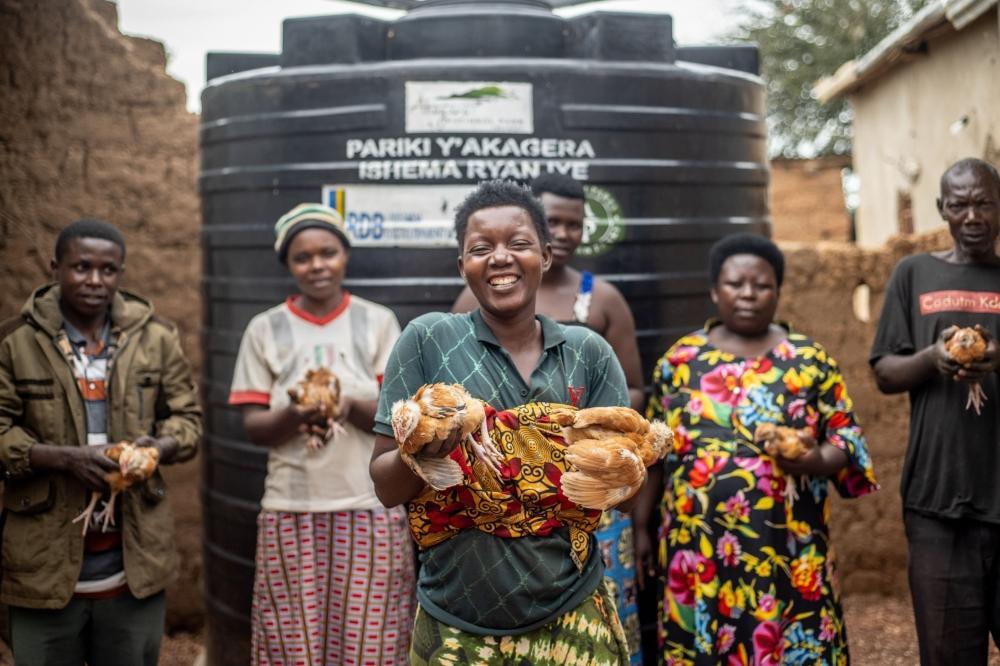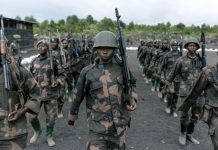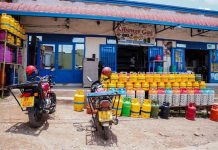Africa-Press – Rwanda. Districts surrounding Akagera National Park received dummy cheques on Saturday worth Rwf1.2 billion under the national Tourism Revenue Sharing programme, which channels part of park earnings back to the communities that live alongside and support conservation.
Akagera is Rwanda’s flagship Savannah and wetland conservation area. It covers about 1,122 square kilometres in the Eastern Province and borders Nyagatare, Gatsibo, and Kayonza districts.
These communities provide much of the labour that keeps the park running, from wildlife monitoring to hospitality work. Many have also become innovators of ecotourism, a form of travel that focuses on responsible visits to natural areas in a way that supports conservation and benefits local people.
Most of the park land falls within Kayonza District, which has long been central to both conservation efforts and community-driven tourism.
The park’s influence extends widely. In total, Akagera directly impacts nine sectors, eighteen cells, and eighty-four villages. More than 470,000 people live in areas that interact with the park either through employment, small businesses, or the day-to-day realities of living near wildlife.
Under the national policy that sets aside 10 percent of park tourism revenue for neighbouring communities, Kayonza received the largest share at Rwf857 million.
Akagera is Rwanda’s flagship savannah and wetland conservation area, covering about 1,122 square kilometres in the Eastern Province and bordering Nyagatare, Gatsibo, and Kayonza districts.
Nyagatare followed with Rwf285 million, and Gatsibo received Rwf142 million. The combined allocation adds up to Rwf1.286 billion for the 2025 to 2026 fiscal year.
Nyagatare District officials say the support targets two sectors that border Akagera National Park, Karangazi and Rwimiyaga. Between 2019 and 2024, the district received Rwf686.2 million through the revenue sharing scheme.
Of that amount, Rwf568 million went into infrastructure projects and Rwf118.2 million supported income generating activities for local residents.
The infrastructure investments focused on improving daily life for communities near the park. They include solar-powered water pumps that help households access clean water, new Early Childhood Development centres where young children receive basic care and learning support, mobile market structures where traders can sell goods, electricity supply, and science equipment for schools.
The district has also invested in projects that help families earn an income. These range from providing small livestock to supporting livestock cooperatives and handicraft groups.
Local leaders say these efforts have lifted many households out of poverty and strengthened the overall wellbeing of communities living along the park’s boundary.
As the cheques were presented, residents used the moment to voice the needs they believe are most urgent. In Kayonza District, residents from Kabare, Rwinkwavu, and Ndego sectors called for the construction of a youth centre that would offer health services.
They said the space would help young people access essential care, reduce early pregnancies, and lower vulnerability to HIV and other diseases.
D’Amour Ayobahorana, a resident, said such a facility would also help young people find purpose.
“The proposed youth friendly facility would go a long way towards eliminating some issues our youth face, the most pressing being employment. These centres are also known to support creative talents. In my opinion, this is a good thing because time spent doing productive activities that can even earn money when developed well is better than roaming the streets and stealing from the little the population has been building,” he said.
Others highlighted the ongoing challenge of clean water access, an issue that shapes daily life for thousands. Many communities still walk long distances to reach water sources or visit health posts.
Jean-Claude Habihirwe, who operates a culture based tourism business near the park, said his proposal focuses on bringing clean water to more than one thousand homes using a solar-powered system.
“I would love to see projects around universal clean water receive attention. When a community has access to clean water, a lot can be achieved,” he said. “We also do not have access to electricity, so the project uses solar.”
Kayonza District Mayor John Bosco Nyemazi welcomed the community proposals and said they reflect the district’s shared priorities. He noted that suggestions from residents will continue to guide planning throughout the year, especially for projects that strengthen local resilience and support families living near the park.
The conservation perspective was also a central part of the discussions. Jean Paul Karinganire, Funding and Reporting Manager at Akagera Management Company, the body that manages the park under African Parks, said community proposals and conservation policies must work hand in hand.
He explained that residents are encouraged to plant trees, avoid burning vegetation, and help prevent poaching. Bush burning is considered harmful because fires destroy small animals and insects that are important for the ecosystem. Poaching has declined sharply over the past decade due to community involvement and consistent enforcement.
Karinganire also highlighted how conservation contributes to the national economy through tourism and employment. The park fits into Rwanda’s broader development strategy known as NST2, which prioritises environmental protection and sees conservation as a critical contributor to national growth.
“We appreciate the investments in hospitality facilities all across the park. These facilities do not only host our guests but also increase the number of people we employ. Seventy percent of them are youth. The park employs 326 people full-time, and more than 200 freelancers who earn over $400,000 every year.
They work as guides, drivers, captains, and balloon operators. The more we conserve this area, the more people from these communities are selected to come and serve,” he said.
The tourism revenue sharing scheme was introduced in 2005 as a way to reduce poaching and improve livelihoods around national parks. It began by returning five percent of park revenues to communities. The policy now returns ten percent each year.
The principle is simple. When communities benefit directly from tourism, they are more likely to protect the natural resources that attract visitors in the first place. Since 2010, Akagera has channelled about 4.7 million dollars, or roughly Rwf6.8 billion, into community development through revenue sharing and special grants.
The amount has grown steadily as tourism activity increases and as communities around the park take a more active role in conservation.
According to the Rwanda Development Board, more than Rwf10 billion has been invested in over 1,000 community projects around Akagera, Nyungwe, Volcanoes, and Gishwati-Mukura national parks since the programme began. The impact is visible in schools, water systems, small tourism businesses, and community centres spread across the country.
For communities around Akagera, the latest allocations mark another step toward turning conservation into a shared, long term opportunity rather than a barrier.
Children sit in a classroom built using funds from park tourism revenue. Under the national policy that allocates 10% of tourism earnings to neighbouring communities, Kayonza District received the largest share Rwf 857 million. Courtesy
A man fetches water from a supply system funded by Akagera National Park. The park’s influence extends across nine sectors, 18 cells, and 84 villages. Courtesy

For More News And Analysis About Rwanda Follow Africa-Press








